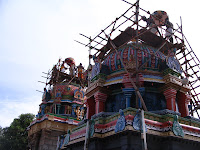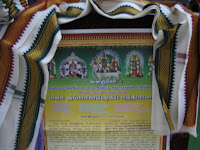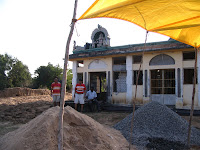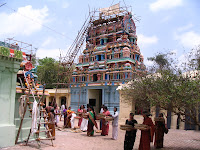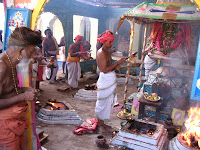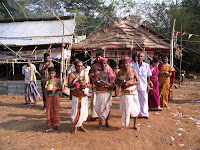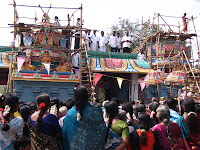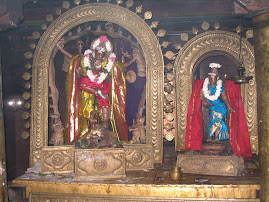 Sri Kailasanatha Swamy Temple,Coonanjeri is being given final touches to perform the great event that takes places after several decades.
Sri Kailasanatha Swamy Temple,Coonanjeri is being given final touches to perform the great event that takes places after several decades. 


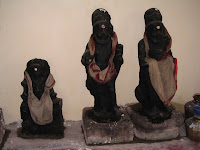 Our Sabha has responded to the request for Coonanjeri Temple by donating vastrams (for the forthcoming Kumbabhishekam on 6th Sept.) Sri Lakshminarayanan of Kumbakonam was kind enough to accompany me to visit this temple.As informed in the last blog,some more pictures of the temple are uploaded and attached.
Our Sabha has responded to the request for Coonanjeri Temple by donating vastrams (for the forthcoming Kumbabhishekam on 6th Sept.) Sri Lakshminarayanan of Kumbakonam was kind enough to accompany me to visit this temple.As informed in the last blog,some more pictures of the temple are uploaded and attached. Earlier, I participated in the Kumbabhishekam of Sri Neelakandeswara Swami temple at Ilup papattu,near Mayiladuthurai. Yagasala poojas were conducted as per Sivagama and the Head of Thiruvavaduthurai Mutt was present during the 6th kaala pooja followed by Kumbabhishekam. He also unveiled the "Thiruppadiga Kalvettu". Our Sabha had erected a grill to protect the Utsava murthis and Kalvettu here.The uploaded pictures are attached for you to have the dharshan of Kumbabishekam.
papattu,near Mayiladuthurai. Yagasala poojas were conducted as per Sivagama and the Head of Thiruvavaduthurai Mutt was present during the 6th kaala pooja followed by Kumbabhishekam. He also unveiled the "Thiruppadiga Kalvettu". Our Sabha had erected a grill to protect the Utsava murthis and Kalvettu here.The uploaded pictures are attached for you to have the dharshan of Kumbabishekam.
 papattu,near Mayiladuthurai. Yagasala poojas were conducted as per Sivagama and the Head of Thiruvavaduthurai Mutt was present during the 6th kaala pooja followed by Kumbabhishekam. He also unveiled the "Thiruppadiga Kalvettu". Our Sabha had erected a grill to protect the Utsava murthis and Kalvettu here.The uploaded pictures are attached for you to have the dharshan of Kumbabishekam.
papattu,near Mayiladuthurai. Yagasala poojas were conducted as per Sivagama and the Head of Thiruvavaduthurai Mutt was present during the 6th kaala pooja followed by Kumbabhishekam. He also unveiled the "Thiruppadiga Kalvettu". Our Sabha had erected a grill to protect the Utsava murthis and Kalvettu here.The uploaded pictures are attached for you to have the dharshan of Kumbabishekam. On your right,you can see the  sthala mahathmiyam,wherein Sri Parva
sthala mahathmiyam,wherein Sri Parva thi and Parameshwara sitting in Pranava boat during Pralaya and reaching Ilupappattu enroute to Sirkazhi. On the left,you can see the sivacharyars taking sangalpam prior to yagasala pooja near the Holy Iluppai tree.
thi and Parameshwara sitting in Pranava boat during Pralaya and reaching Ilupappattu enroute to Sirkazhi. On the left,you can see the sivacharyars taking sangalpam prior to yagasala pooja near the Holy Iluppai tree.
Yagasala was decorated well and it had 36 kundams. Yagasala poojas were performed for six kaalams. Hundreds of people had dharshan of Holy water being poured over the kalasams of Sri Neelakandeswara,Sri Amritha kara valli and other deities. sthala mahathmiyam,wherein Sri Parva
sthala mahathmiyam,wherein Sri Parva thi and Parameshwara sitting in Pranava boat during Pralaya and reaching Ilupappattu enroute to Sirkazhi. On the left,you can see the sivacharyars taking sangalpam prior to yagasala pooja near the Holy Iluppai tree.
thi and Parameshwara sitting in Pranava boat during Pralaya and reaching Ilupappattu enroute to Sirkazhi. On the left,you can see the sivacharyars taking sangalpam prior to yagasala pooja near the Holy Iluppai tree.